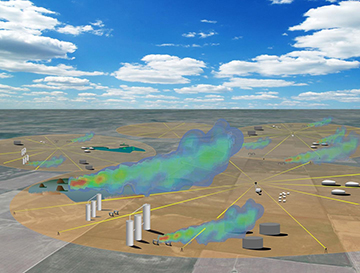Illustration showing how trace gases are detected in the field using a mobile dual-frequency-comb laser spectrometer. [Image: Stephanie Sizemore and Ian Coddington / U.S. National Institute of Standards and Technology] [Enlarge image]
Researchers from the University of Colorado Boulder, USA, have field-tested a new air quality testing system based on frequency comb laser spectroscopy and paired with atmospheric inversion modeling that they say can continuously and autonomously monitor for methane gas leaks (Optica, doi: 10.1364/OPTICA.5.000320). The researchers report that during field tests, they were able to detect trace amounts of methane over an area of several square kilometers at flow rates equivalent to 25 percent of an individual’s resting breathing rate.
The portable dual-comb laser spectrometer system has already attracted attention from industrial partners that are working with the research team to further develop and evaluate the system for use in oil and gas facilities.
From snapshot view to continuous monitoring
Methane gas vented from human activities poses a risk to public safety, contributes to climate change and also represents a monetary loss for oil and gas storage sites and processing plants. Currently, one of the most common approaches to methane detection relies on a person using an infrared (IR) camera to check for gas leaks over large areas of land. This work is time-consuming and expensive and provides only a snapshot-in-time estimation of emissions. Aircraft- and car-mounted IR cameras are another option, but these methods are also expensive and impractical for continuous monitoring.
The UC Boulder team claims to have improved on the current state of the art in methane detection with an autonomous and continuous monitoring system based on the frequency comb technology developed by Nobel Laureate and UC Boulder faculty member John Hall. By using laser frequency comb technology as the basis for a spectrometer, the researchers created a tool that could measure with high resolution, over a broad range of wavelengths, the light-absorption fingerprint of methane gas molecules quickly and accurately.
Putting two frequency combs together, in a dual-comb setup, can dramatically improve the speed and spectral resolution of frequency comb spectroscopy (see “Dual-comb spectroscopy,” OPN, January 2017). And combining dual-comb spectroscopy with innovations in atmospheric inversion modeling allows the monitoring unit to also pinpoint the location of a gas leak and calculate its emission rate.
Field-testing the dual-comb spectrometer
For outdoor field tests, the researchers set up the dual-comb spectrometer at UC Boulder’s Table Mountain research facility. The 19-inch spectrometer was placed on a 360-degree swiveling base in the center of a circle about one kilometer in diameter and ringed with retroreflecting mirrors. Within the circle were randomly placed canisters leaking methane gas.
When the spectrometer was turned on, it emitted a multi-wavelength beam of light in the direction of a retroreflecting mirror. If the beam of light passed through a cloud of methane gas, then the gas molecules absorbed certain wavelengths before the light hit the mirror and returned to the detector. By looking at which wavelengths of light were absorbed, the researchers could determine if that particular section of the circular “pie” contained methane gas. Atmospheric inversion modeling applied to data from the reflected beams allowed the researchers to calculate and pinpoint the location of the methane gas and the rate at which it was leaving the canisters.
During these field tests, the researchers report being able to detect gas emissions as low as 1.6 grams per minute at a distance of one kilometer and at emission rates 1,000 times lower than current approaches. They were also able to detect two simultaneous gas leaks in an area with up to five potential sources.
The research team is made up of members from UC Boulder, the U.S. National Institute of Standards and Technology and the U.S. National Oceanic and Atmospheric Administration.

